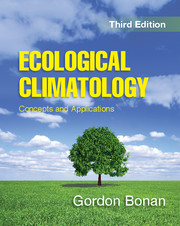Book contents
- Frontmatter
- Dedication
- Contents
- Preface
- 1 Ecosystems and Climate
- Part I The Earth System
- Part II Global Physical Climatology
- 4 Atmospheric Radiation
- 5 Atmospheric General Circulation and Climate
- 6 Earth's Climates
- 7 Climate Variability
- 8 Climate Change
- Part III Hydrometeorology
- Part IV Biometeorology
- Part V Terrestrial Plant Ecology
- Part VI Terrestrial Forcings and Feedbacks
- Appendix
- Index
- Plate section
5 - Atmospheric General Circulation and Climate
from Part II - Global Physical Climatology
Published online by Cambridge University Press: 05 November 2015
- Frontmatter
- Dedication
- Contents
- Preface
- 1 Ecosystems and Climate
- Part I The Earth System
- Part II Global Physical Climatology
- 4 Atmospheric Radiation
- 5 Atmospheric General Circulation and Climate
- 6 Earth's Climates
- 7 Climate Variability
- 8 Climate Change
- Part III Hydrometeorology
- Part IV Biometeorology
- Part V Terrestrial Plant Ecology
- Part VI Terrestrial Forcings and Feedbacks
- Appendix
- Index
- Plate section
Summary
Chapter Summary
Geographic variation in the annual radiative balance at the top of the atmosphere drives the general circulation of the atmosphere and produces the major patterns of climate on Earth. The latitudinal gradient in net radiation results in an equator-to-pole temperature gradient. However, if only radiative processes determined temperatures, the tropics would be tens of degrees warmer than they actually are, and polar regions would be much colder than they actually are. Instead, the uneven geographic distribution of radiation produces winds, set in motion by differences in air pressure, that redistribute heat from the tropics to the poles. Winds are a balance of the pressure gradient force, Coriolis force, and friction acting simultaneously. These forces produce the general circulation of the atmosphere. The continents alter this idealized circulation because landmasses heat and cool faster than oceans. In winter, when the landmasses of the Northern Hemisphere are colder than oceans, high pressure systems form over land while low pressure systems are most pronounced over oceans. The opposite pattern occurs in summer when continents are warmer than oceans. Oceans also influence climate by transporting heat poleward. Prominent ocean circulations are wind-driven surface currents and the density-driven thermohaline circulation. The general circulation of the atmosphere varies over the course of a year in response to seasonal changes in solar radiation. These seasonal changes in surface high and low pressure regions and atmospheric circulation drive seasonal changes in precipitation. Monsoons are one such prominent large-scale seasonal atmospheric circulation.
Air Pressure
Air pressure is the force exerted over a given area by the movement of air molecules. Air pressure is also a measure of the mass of air above a given point. Air pressure decreases with greater height above sea level because there are fewer air molecules, and less mass, with greater altitude.
The change in air pressure with height is described by the hydrostatic equation, which relates the upward force on a parcel of air due to the decrease in pressure with height to the downward force from gravity.
- Type
- Chapter
- Information
- Ecological ClimatologyConcepts and Applications, pp. 74 - 88Publisher: Cambridge University PressPrint publication year: 2015



